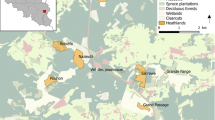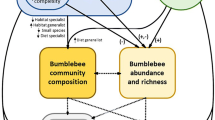Abstract
Understanding the effects of local and landscape factors on bumblebees is relevant for the conservation of this group of pollinators. Bumblebees have been well-studied in agricultural landscapes of Western Europe, Asia and North America, but few studies have been developed on bumblebees in forest-dominated landscapes of Eastern Europe. We developed this study in 22 semi-natural meadows located in a patchy forested landscape of Estonia. We investigated the influence of habitat characteristics and landscape factors (calculated at four spatial scales: 250, 500, 1,000 and 2,000 m radius) on the total species richness and abundance of bumblebees. Correlation analysis, partial least squares (PLS) and stepwise forward-selection multiple regression analysis were applied in this study. The presence of a high diversity of flowering plants in semi-natural meadows may benefit the abundance of bumblebees. At the local level, patch area and shape seem to have positive and negative influences, respectively, on bumblebee species richness. At the landscape level, human settlements with the presence of gardens may favour bumblebee richness and abundance. Also, bumblebee species may increase with a high presence of meadows in the landscape, and may decrease with high percentages of forest and young forest. Overall, forested landscapes with a strong presence of edges and a diverse matrix may support a higher species richness and abundance of bumblebees. Both local and landscape factors should be considered when designing conservation strategies and agri-environmental measures.


Similar content being viewed by others
References
Ahrné K, Bengtsson J, Elmqvist T (2009) Bumble bees (bombus spp) along a gradient of increasing urbanization. PLoS ONE 4:e5574
Bäckman JP, Tiainen J (2002) Habitat quality of filed margins in a Finnish farmland area for bumblebees (Hymenoptera: Bombus and Psithyrus). Agr Ecosyst Environ 89:53–68
Carrascal LM, Galván I, Gordo O (2009) Partial least squares regression as an alternative to current regression methods used in ecology. Oikos 118:681–690
Carvell C (2002) Habitat use and conservation of bumblebees (Bombus spp) under different grassland management regimes. Biol Conserv 103:33–49
Chapman RE, Wang J, Bourke AFG (2003) Genetic analysis of spatial foraging patterns and resource sharing in bumble bee pollinators. Mol Ecol 12:2801–2808
Cozzi G, Müller CB, Krauss J (2008) How do local habitat management and landscape structure at different spatial scales affect fritillary butterfly distribution on fragmented wetlands? Landscape Ecol 23:269–283
Cussans J, Goulson D, Sanderson R, Goffe L, Darvill B, Osborne JL (2010) Two bee-pollinated plant species show higher seed production when grown in gardens compared to arable farmland. PLoS ONE 5:e11753
Eiden G, Kayadjanian M, Vidal C (2000) Capturing landscape structures: Tools. The European Commission. http://ec.europa.eu/agriculture/publi/landscape/ch1.htm. Accessed 10 Oct 2011
Fauna Europaea (2011) Fauna Europaea version 2.4. http://www.faunaeur.org. Accessed 15 June 2011
Forman RTT, Godron M (1986) Landscape ecology. Wiley, New York
Freemark K, Bert D, Villard MA (2002) Patch-, landscape-, and regional-scale effects on biota. In: Gutzwiller KJ (ed) Applying landscape ecology in biological conservation. Springer, New York, pp 58–83
Goulson D (2010) Bumblebees: behaviour, ecology and conservation. Oxford University Press, Oxford
Goulson D, Darvill B (2004) Niche overlap and diet breadth in bumblebees; are rare species more specialized in their choice of flowers? Apidologie 35:55–64
Goulson D, Hughes WHO, Derwent LC, Stout JC (2002) Colony growth of the bumblebee, Bombus terrestris, in improved and conventional agricultural and suburban habitats. Oecologia 130:267–273
Goulson D, Hanley ME, Darvill B, Ellis JS, Knight ME (2005) Causes of rarity in bumblebees. Biol Conserv 122:1–8
Goulson D, Hanley ME, Darvill B, Ellis JS (2006) Biotope associations and the decline of bumblebees (Bombus spp). J Insect Conserv 10:95–103
Goulson D, Lepais O, O’Connor S, Osborne JL, Sanderson LA, Cussans J, Goffe L, Darvill B (2010) Effects of land use at a landscape scale on bumblebee nest density and survival. J Appl Ecol 47:1207–1215
Goulson D, Rayner P, Dawson B, Darvill B (2011) Translating research into action; bumblebee conservation as a case study. J Appl Ecol 48:3–8
Gutzwiller KJ (2002) Spatial factors affecting organism occurrence, movement, and conservation: introduction to section II. In: Gutzwiller KJ (ed) Applying landscape ecology in biological conservation. Springer, New York, pp 55–57
Hagen M, Wikelski M, Kissling WD (2011) Space use of bumblebees (Bombus spp) revealed by radio tracking. PLoS ONE 6(5):e19997
Hatfield RG, LeBuhn G (2007) Patch and landscape factors shape community assemblage of bumble bees, Bombus spp. (Hymenoptera: Apidae), in montane meadows. Biol Conserv 139:150–158
Holzschuh A, Steffan-Dewenter I, Tscharntke T (2008) Agricultural landscapes with organic crops support higher pollinator diversity. Oikos 117:354–361
Jauker F, Diekötter T, Schwarzbach F, Wolters V (2009) Pollinator dispersal in an agricultural matrix: opposing responses of wild bees and hoverflies to landscape structure and distance from main habitat. Landscape Ecol 24:547–555
Kells AR, Goulson D (2003) Preferred nesting sites of bumblebee queens (Hymenoptera: Apidae) in agroecosystems in the UK. Biol Conserv 109:165–174
Kivinen S, Luoto M, Kuussaari M, Helenius J (2006) Multi-species richness of boreal agricultural landscapes: effects of climate, biotope, soil and geographical location. J Biogeogr 33:862–875
Kleijn D, Baquero RA, Clough Y et al (2006) Mixed biodiversity benefits of agri-environment schemes in five European countries. Ecol Lett 9:243–254
Knight ME, Osborne JL, Sanderson RA, Hale RJ, Martin AP, Goulson D (2009) Bumblebee nest density and the scale of available forage in arable landscapes. Insect Conserv Divers 2:116–124
Krauss J, Steffan-Dewenter I, Tscharntke T (2003) How does landscape context contribute to effects of habitat fragmentation on diversity and population density of butterflies? J Biogeogr 30:889–900
Krewenka KM, Holzschuh A, Tscharntke T, Dormann CF (2011) Landscape elements as potential barriers and corridors for bees, wasps and parasitoids. Biol Conserv 144:1816–1825
Kreyer D, Oed A, Walther-Hellwig K, Frankl R (2004) Are forests potential landscape barriers for foraging bumblebees? Landscape scale experiments with Bombus terrestris agg and Bombus pascuorum (Hymenoptera, Apidae). Biol Conserv 116(1):111–118
Krishnan A, Williams LJ, McIntosh AR, Abdi H (2011) Partial least squares (PLS) methods for neuroimaging: a tutorial and review. NeuroImage 56:455–475
Kumar S, Simonson SE, Stohlgren TJ (2009) Effects of spatial heterogeneity on butterfly species richness in Rocky Mountain National Park, CO, USA. Biodivers Conserv 18:739–763
Le Féon V, Schermann-Legionneta A, Delettrea Y et al (2010) Intensification of agriculture, landscape composition and wild bee communities: a large scale study in four European countries. Agr Ecosyst Environ 137:143–150
Mänd M, Mänd R, Williams IH (2002) Bumblebees in the agricultural landscape of Estonia. Agr Ecosyst Environ 89:69–76
Manning AD, Lindenmayer DB, Nix HA (2004) Continua and Umwelt: alternative ways of viewing landscapes. Oikos 104:621–628
Mazerolle MJ, Villard MA (1999) Patch characteristics and landscape context as predictors of species presence and abundance: a review. Ecoscience 6:117–124
McFrederick QS, LeBuhn G (2006) Are urban parks refuges for bumble bees Bombus spp (Hymenoptera: Apidae)? Biol Conserv 129:372–382
McGarigal K, Marks BJ (1995) FRAGSTATS: spatial pattern analysis program for quantifying landscape structure. Gen. Tech. Rep. PNW-GTR-351 Portland, OR: US Department of Agriculture, Forest Service, Pacific Northwest Research Station
McGarigal K, Cushman SA, Neel MC, Ene E (2002) FRAGSTATS, spatial pattern analysis program for categorical maps. University of Massachusetts, Amherst
Öckinger E, Smith HG (2006) Landscape composition and habitat area affects butterfly species richness in semi-natural grasslands. Oecologia 149:526–534
Öckinger E, Smith HG (2007) Semi-natural grasslands as population sources for pollinating insects in agricultural landscapes. J Appl Ecol 44:50–59
Osborne JL, Martin AP, Shortall CR, Todd AD, Goulson D, Knight ME, Hale RJ, Sanderson RA (2008) Quantifying and comparing bumblebee nest densities in gardens and countryside habitats. J Appl Ecol 45:784–792
Palang H, Mander Ü, Luud A (1998) Landscape diversity changes in Estonia. Landsc Urban Plan 41:163–169
Peterson U, Aunap R (1998) Changes in agricultural land use in Estonia in the 1990s detected with multitemporal Landsat MSS imagery. Landsc Urban Plan 41:193–201
Potts SG, Biesmeijer JC, Kremen C, Neumann P, Schweiger O, Kunin WE (2010) Global pollinator declines: trends, impacts and drivers. Trends Ecol Evol 25:345–353
Quintana-Ascencio PF, Menges ES (1996) Inferring metapopulation dynamics from patch-level incidence of Florida of scrub plants. Conserv Biol 10(4):1210–1219
Rundlöf M, Nilsson H, Smith HG (2008) Interacting effects of farming practice and landscape context on bumble bees. Biol Conserv 141:417–426
Samways MJ (2005) Insect diversity conservation. Cambridge University Press, New York
Sepp K, Mikk M, Mänd M, Truu J (2004) Bumblebee communities as an indicator for landscape monitoring in the agri-environmental programme. Landsc Urban Plan 67:173–183
Söderman G (1999) Diversity of pollinator communities in Eastern Fennoscandia and Eastern Baltics results from pilot monitoring with yellow traps in 1997–1998. Finnish Environment Institute. Edita Ltd, Helsinki
Statistics Estonia (2012) Statistical database: population by county in 2009. http://www.stat.ee. Accessed 1 April 2012
Steffan-Dewenter I (2003) Importance of habitat area and landscape context for species richness of bees and wasps in fragmented orchard meadows. Conserv Biol 17:1036–1044
Steffan-Dewenter I, Tscharntke T (2000) Butterfly community structure in fragmented habitats. Ecol Lett 3:449–456
Steffan-Dewenter I, Münzenberg U, Bürger C, Thies C, Tscharntke T (2002) Scale-dependent effects of landscape context on three pollinator guilds. Ecology 83:1421–1432
Stewart KEJ, Bourn NAD, Thomas JA (2001) An evaluation of three quick methods commonly used to assess sward height in ecology. J Appl Ecol 38:1148–1154
Svensson B, Langerlöf J, Svensson BG (2000) Habitat preferences of nest-seeking bumble bees (Hymenoptera: Apidae) in an agricultural landscape. Agr Ecosyst Environ 77:247–255
Walther-Hellwig K, Frankl R (2000a) Foraging habitats and foraging distances of bumblebees, Bombus spp (Hym, apidae), in an agricultural landscape. J Appl Entomol 124:299–306
Walther-Hellwig K, Frankl R (2000b) Foraging distances of Bombus muscorum, Bombus lapidarius, and Bombus terrestris (Hymenoptera, Apidae). J Insect Behav 13(2):239–246
Westphal C, Steffan-Dewenter I, Tscharntke T (2006) Bumblebees experience landscapes at different spatial scales: possible implications for coexistence. Oecologia 149:289–300
Williams PH, Osborne JL (2009) Bumblebee vulnerability and conservation world-wide. Apidologie 40:367–387
Winfree R, Griswold T, Kremen C (2007) Effect of human disturbance on bee communities in a forested ecosystem. Conserv Biol 21:213–223
Xie Z, Williams PH, Tang Y (2008) The effect of grazing on bumblebees in the high rangelands of the eastern Tibetan Plateau of Sichuan. J Insect Conserv 12:695–703
Zurbuchen A, Landert L, Klaiber J, Muller A, Hein S, Dorn S (2010) Maximum foraging ranges in solitary bees: only a few individuals have the capability to cover long foraging distances. Biol Conserv 143:669–676
Acknowledgments
This research was funded by targeted financing from the Estonian Ministry of Education and Research (SF1090050s07, SF0170057s09), Estonian Science Foundation Grant No. 7391 and by an applied research project of the Estonian Ministry of Agriculture (T8014PKPK). We would like to thank Prof. Jaan Liira for his useful comments that greatly improved the manuscript.
Author information
Authors and Affiliations
Corresponding author
Rights and permissions
About this article
Cite this article
Diaz-Forero, I., Kuusemets, V., Mänd, M. et al. Influence of local and landscape factors on bumblebees in semi-natural meadows: a multiple-scale study in a forested landscape. J Insect Conserv 17, 113–125 (2013). https://doi.org/10.1007/s10841-012-9490-3
Received:
Accepted:
Published:
Issue Date:
DOI: https://doi.org/10.1007/s10841-012-9490-3




